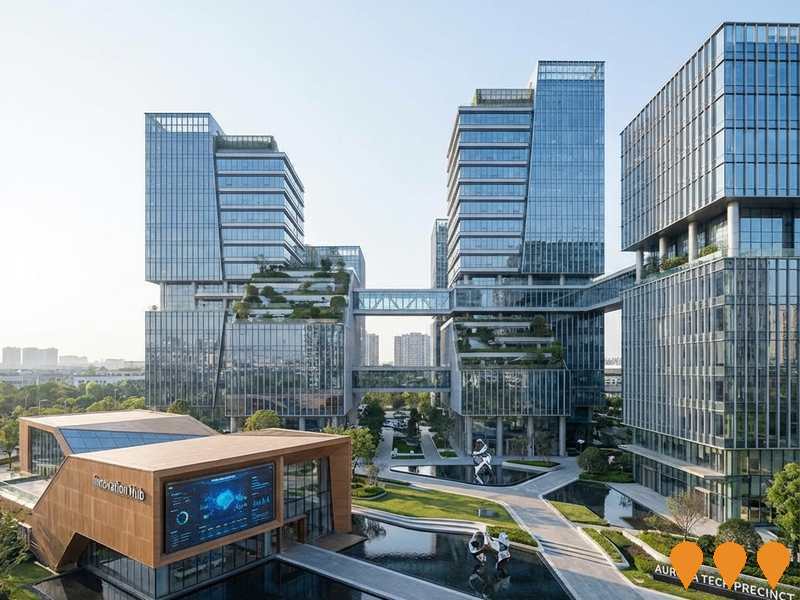Chart Color Schemes
est. as @ -- *
ABS ERP | -- people | --
2021 Census | -- people
Sales Activity
Curious about local property values? Filter the chart to assess the volume and appreciation (including resales) trends and regional comparisons, or scroll to the map below view this information at an individual property level.
Find a Recent Sale
Sales Detail
Population
Pittsworth is positioned among the lower quartile of areas assessed nationally for population growth based on AreaSearch's assessment of recent, and medium term trends
Pittsworth's population is around 5,969 as of Aug 2025. From the 2021 Census to Jun 2024, it increased by 342 people. This includes a rise from 5,791 to 5,933 between Aug 2021 and Jun 2024, as estimated by ABS, plus an additional 75 validated new addresses since the Census date. The population density is 5.7 persons per square kilometer. Pittsworth's growth rate of 3.1% since the census is within 2.0 percentage points of its SA4 region (5.1%). Interstate migration contributed approximately 39.8% to recent population gains, with all drivers being positive factors.
AreaSearch uses ABS/Geoscience Australia projections for each SA2 area, released in 2024 with a base year of 2022. For areas not covered by this data and years post-2032, Queensland State Government's SA2 area projections are adopted, released in 2023 based on 2021 data. These state projections do not provide age category splits; hence proportional growth weightings aligned with ABS Greater Capital Region projections are applied. Considering projected demographic shifts, national non-metropolitan areas' lower quartile growth is anticipated. The area's population is expected to grow by 6 persons to 2041 based on the latest numbers, with a reduction of 0.6% in total over the 17 years.
Frequently Asked Questions - Population
Development
Residential development activity is lower than average in Pittsworth according to AreaSearch's national comparison of local real estate markets
Pittsworth has seen approximately 25 new homes approved annually. Over the past five financial years, from FY-21 to FY-25, a total of 128 homes were approved, with an additional 12 approved so far in FY-26. On average, around 0.4 new residents have arrived per new home each year during these five years, indicating that the supply of new homes is keeping pace with or exceeding demand.
The average construction cost value of new homes over this period was $481,000, aligning with regional trends. This financial year has seen $28.9 million in commercial approvals registered, reflecting high levels of local commercial activity. Compared to the Rest of Qld, Pittsworth has 59.0% more new home approvals per person, offering greater choice for buyers. The building activity shows that 95.0% of dwellings are standalone homes and 5.0% are attached, maintaining the area's traditional low density character with a focus on family homes.
There are approximately 182 people per dwelling approval in Pittsworth, indicating a low density market. Population projections suggest stability or decline, which should reduce housing demand pressures and benefit potential buyers.
Frequently Asked Questions - Development
Infrastructure
Pittsworth has emerging levels of nearby infrastructure activity, ranking in the 24thth percentile nationally
Changes to local infrastructure significantly influence an area's performance. AreaSearch has identified 18 projects likely impacting the area. Notable projects include Colbar Street Subdivision in Pittsworth, The Landing Estate - Pittsworth, and Tuana Park Estate. Relevant projects are detailed below.
Professional plan users can use the search below to filter and access additional projects.
INFRASTRUCTURE SEARCH
 Denotes AI-based impression for illustrative purposes only, not to be taken as definitive under any circumstances. Please follow links and conduct other investigations from the project's source for actual imagery. Developers and project owners wishing us to use original imagery please Contact Us and we will do so.
Denotes AI-based impression for illustrative purposes only, not to be taken as definitive under any circumstances. Please follow links and conduct other investigations from the project's source for actual imagery. Developers and project owners wishing us to use original imagery please Contact Us and we will do so.
Frequently Asked Questions - Infrastructure
Wellcamp Aerospace and Defence Precinct
Wagner Corporation's $550-1,000M aerospace and defence precinct at Toowoomba Wellcamp Airport, anchored by Boeing's 9,000sqm MQ-28 Ghost Bat production facility - Australia's first military combat aircraft designed, developed and manufactured in over 50 years. Includes advanced manufacturing (carbon fibre composites, robotic assembly), part of a larger 300-430ha master-planned business park with passenger airport, international freight hub, and multi-modal connections including Inland Rail. Expected to create 600+ construction jobs, 170+ ongoing operational roles, and generate up to $1 billion for Queensland's economy over 10 years.
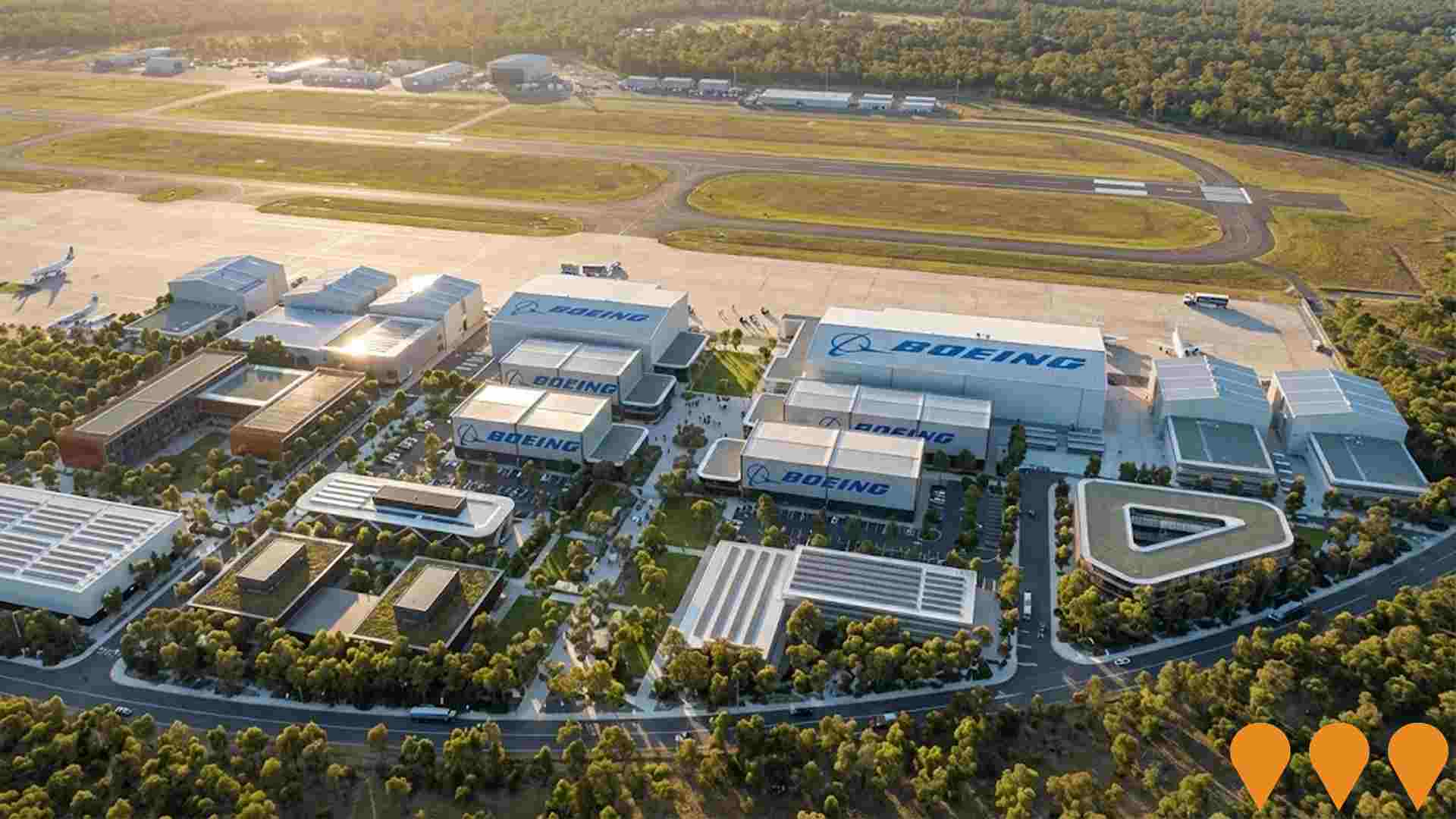
Toowoomba Second Range Crossing (TSRC)
A $1.6 billion, 41-kilometre bypass north of Toowoomba connecting the Warrego Highway at Helidon to the Gore Highway at Athol. Key features include an 800-metre Multuggerah Viaduct, 24 bridges, and 6 interchanges. Opened on 8 September 2019, it removes 80% of heavy commercial vehicles from Toowoomba CBD, saves up to 40 minutes travel time, and created approximately 1,800 jobs during construction. Owned by Queensland Government (TMR), built and operated by Nexus Infrastructure consortium. Major highway infrastructure enhancing freight movement between Brisbane and Melbourne.
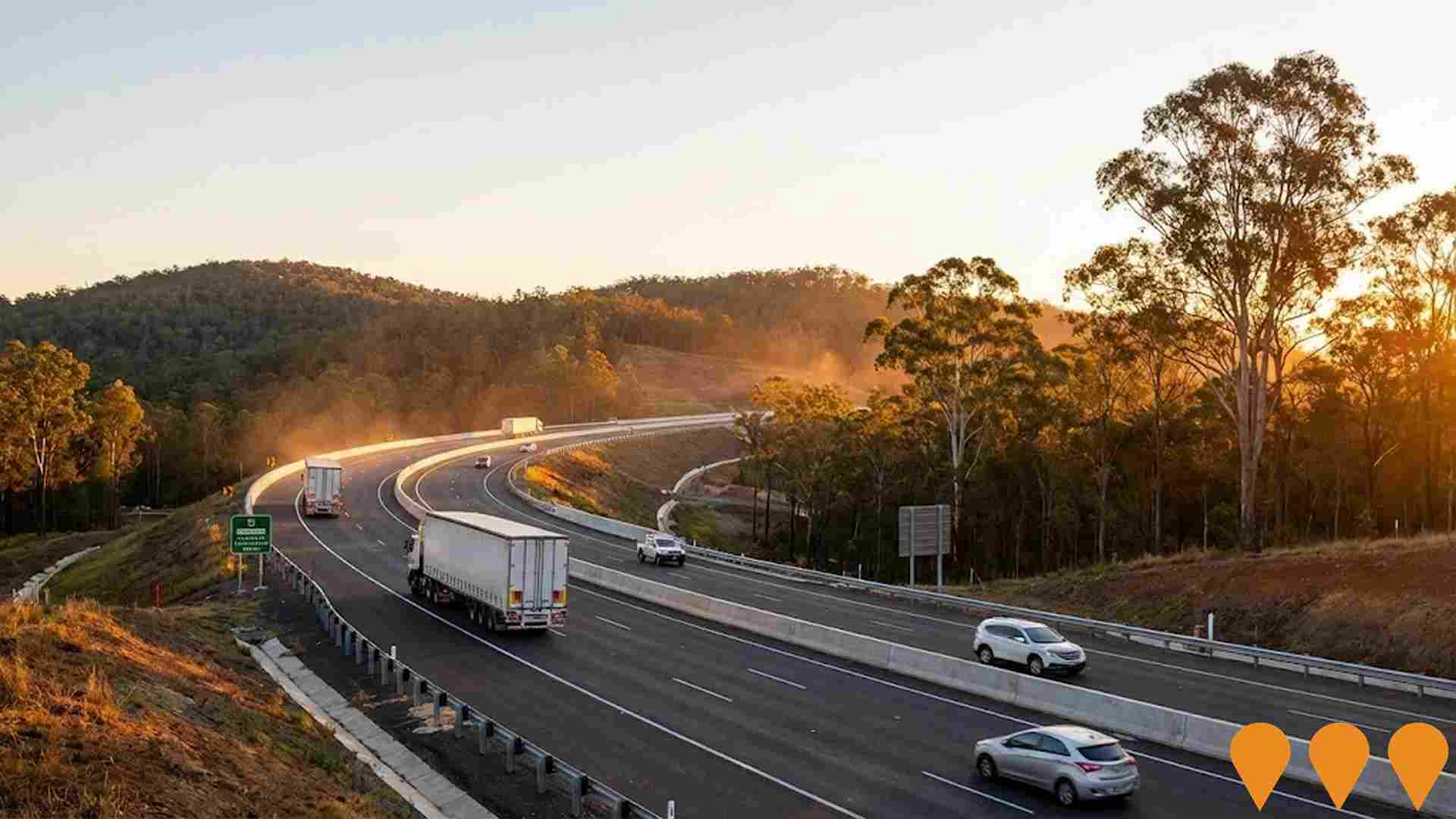
Wellcamp Entertainment Precinct
A proposed $175-200 million entertainment and motorsport precinct by Wagner Corporation adjacent to Toowoomba Wellcamp Airport. Key features include a 40,000-seat covered amphitheatre/performing arts venue, international-standard motor racing circuit (Will Power Centre for Motorsport), driver training facilities, motocross and karting complexes, Olympic-standard sporting facilities, camping/RV areas and supporting tourism infrastructure. Intended to host major concerts, international motorsport events and support Brisbane 2032 Olympics training and events.
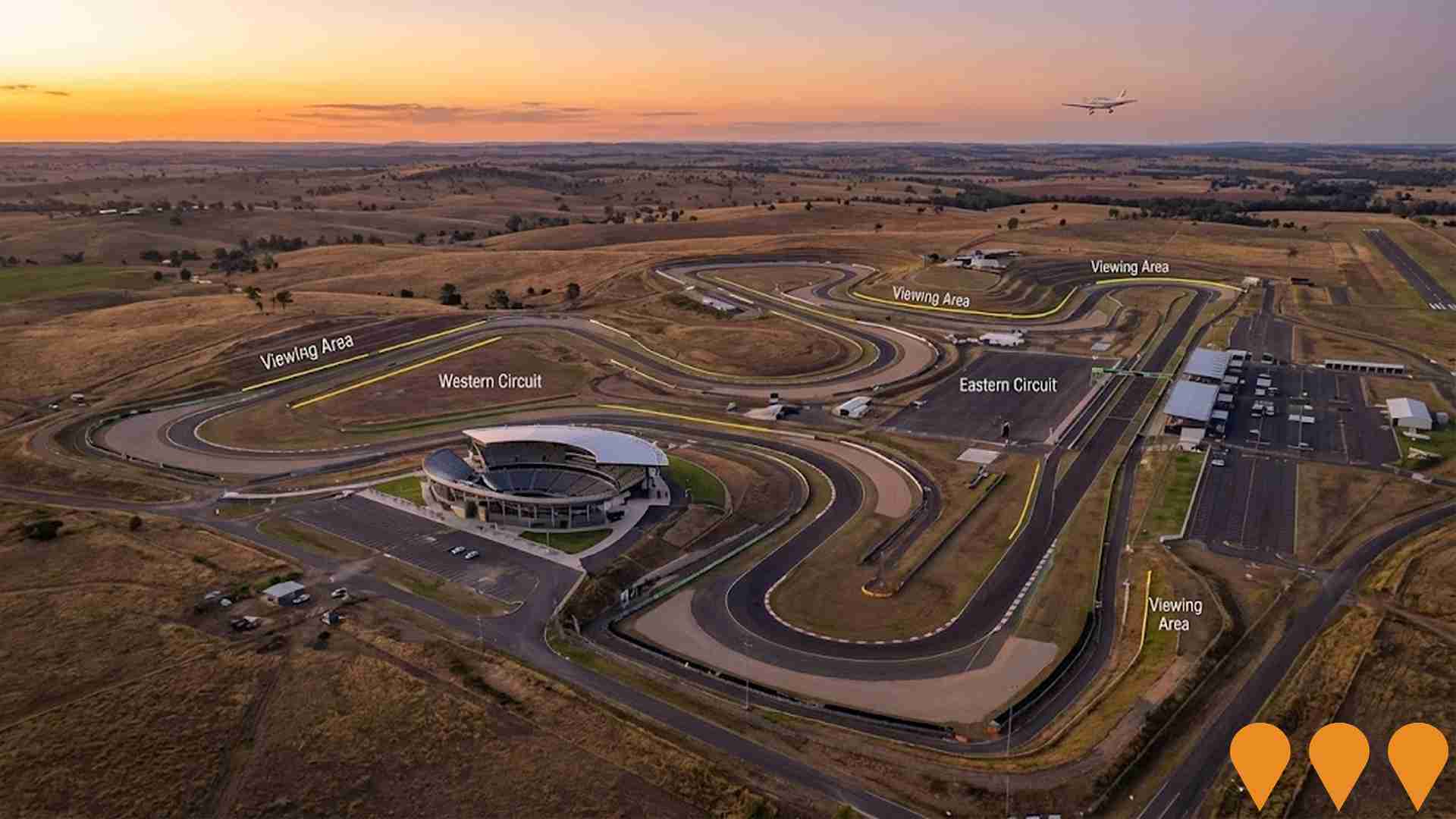
Toowoomba Wellcamp Airport Terminal Expansion
Planned expansion of passenger terminal facilities at Toowoomba Wellcamp Airport (WTB) to accommodate future growth in passenger movements and to integrate with broader precinct upgrades, including cargo capacity expansion and the emerging Aerospace & Defence Precinct.

Inland Rail - NSW/Queensland Border to Gowrie (B2G)
The Border to Gowrie (B2G) section of Inland Rail is a ~217km segment (149km new dual-gauge track and 68km upgraded existing track) connecting the NSW/QLD border near Yelarbon (18km southeast of Goondiwindi) to Gowrie Junction northwest of Toowoomba. Part of the Melbourne-to-Brisbane Inland Rail freight corridor. As of November 2025, the project is in the approvals phase following closure of public consultation on the revised draft EIS (12 May - 4 August 2025). Inland Rail is preparing a response to submissions for the Queensland Coordinator-General. Subject to approvals, major construction expected to commence by 2029, taking ~4 years.
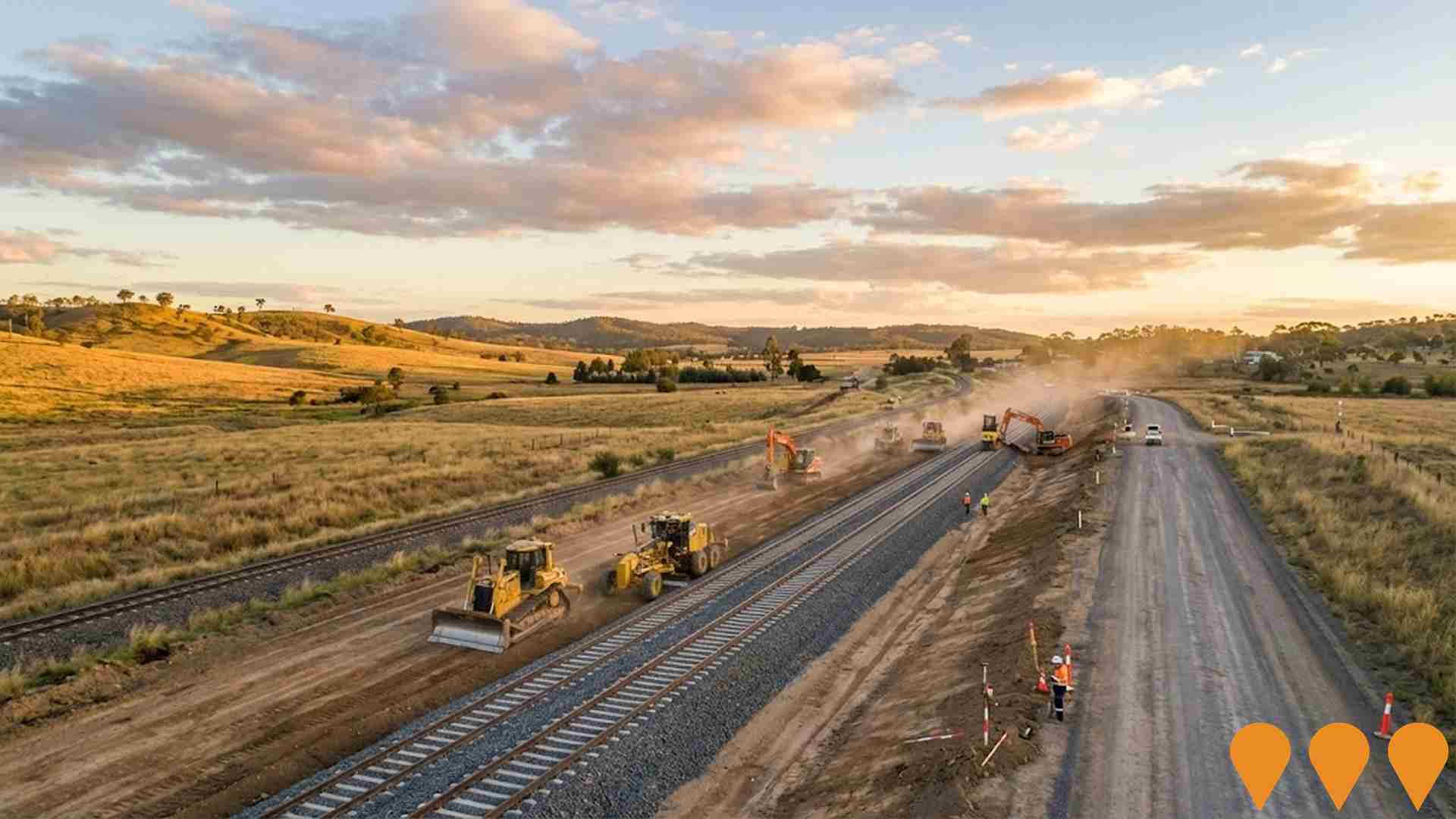
Herries Range Wind Farm
180 wind turbines wind farm project in the Warwick/Toowoomba region. Major renewable energy infrastructure with 1,000MW capacity as part of MacIntyre Wind Precinct. $2 billion investment creating 600 construction jobs.

Wellcamp Global Automotive Testing & Research Facility
A $650 million automotive testing and research facility by Gondwana Australia. Designed to be a world-class testing ground for automotive manufacturers and research institutions.
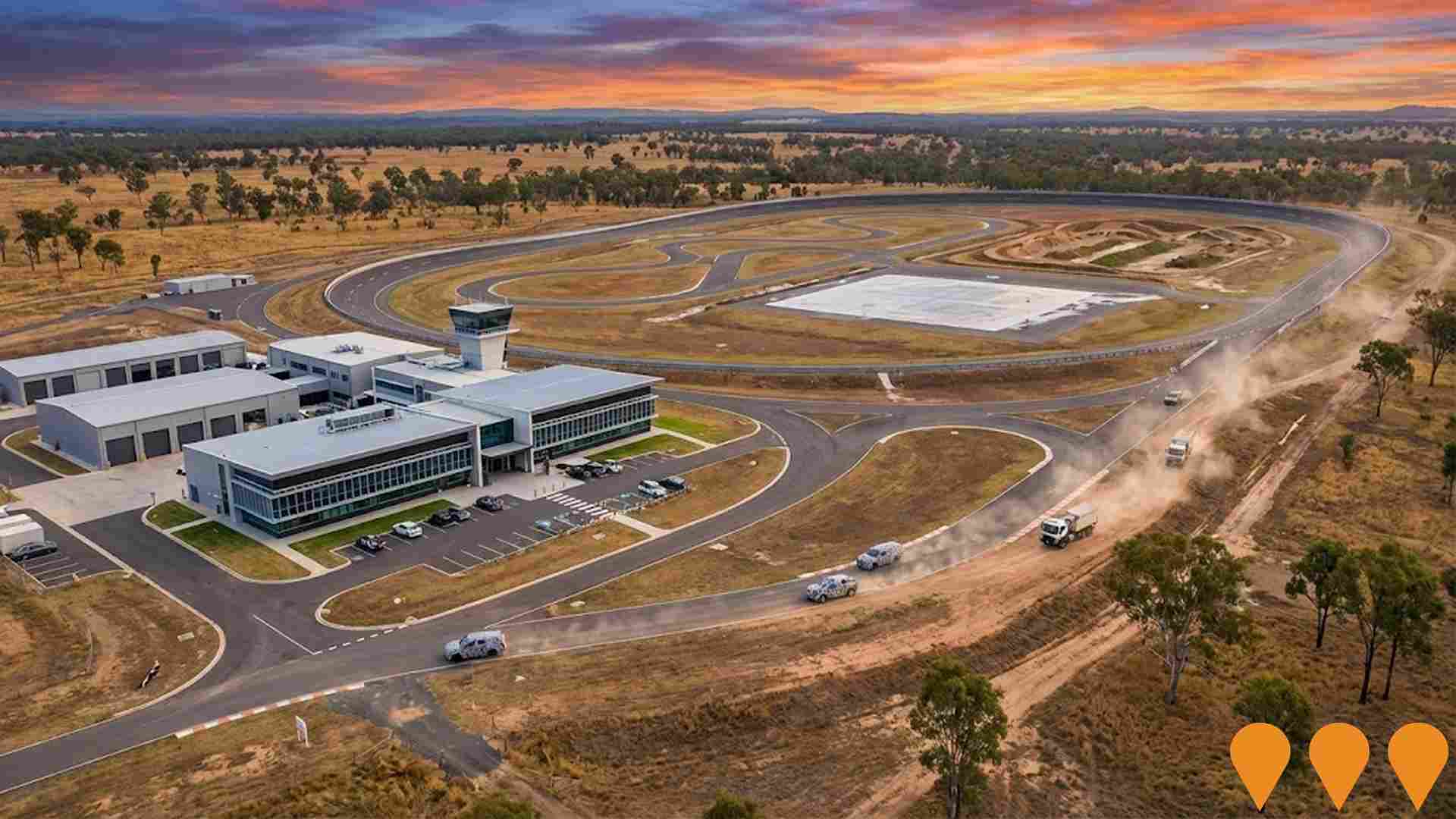
Colbar Street Subdivision, Pittsworth
35-lot residential subdivision in Pittsworth. Rhodeland Group secured Development Approval and managed design and tender. Lots released to market in Aug 2023 with guide pricing from $180,000.

Employment
Employment conditions in Pittsworth rank among the top 10% of areas assessed nationally
Pittsworth has a balanced workforce with both white and blue collar jobs, representing various sectors. Its unemployment rate was 1.6% as of June 2025, with an estimated employment growth of 5.2% over the past year.
As of this date, 3,107 residents were employed while the unemployment rate was 2.4% lower than Rest of Qld's rate of 3.9%. Workforce participation in Pittsworth was on par with Rest of Qld's 59.1%. Key industries for employment among residents are agriculture, forestry & fishing, health care & social assistance, and construction. Pittsworth has a particularly strong specialization in agriculture, forestry & fishing, with an employment share 4.9 times the regional level.
However, health care & social assistance is under-represented, with only 11.6% of Pittsworth's workforce compared to 16.1% in Rest of Qld. Employment opportunities locally may be limited, as indicated by the count of Census working population versus resident population. Over the 12 months to June 2025, employment increased by 5.2% while labour force increased by 5.8%, causing the unemployment rate to rise by 0.5 percentage points. In contrast, Rest of Qld experienced employment growth of 1.8% and labour force growth of 2.0%, with a 0.2 percentage point rise in unemployment rate. Jobs and Skills Australia's national employment forecasts from May 2025 suggest potential future demand within Pittsworth. These projections estimate national employment growth at 6.6% over five years and 13.7% over ten years, but growth rates vary significantly between industry sectors. Applying these projections to Pittsworth's employment mix suggests local growth of approximately 5.2% over five years and 11.6% over ten years, although these are simple weighted extrapolations for illustrative purposes and do not account for localised population projections.
Frequently Asked Questions - Employment
Income
Income levels sit below national averages according to AreaSearch assessment
Income in Pittsworth during financial year 2022 was lower than national averages. The median income was $47,002 and the average income was $61,092. In comparison, Rest of Qld had a median income of $50,780 and an average income of $64,844. Based on Wage Price Index growth of 13.99% since financial year 2022, estimated incomes as of September 2025 would be approximately $53,578 (median) and $69,639 (average). Census 2021 data shows income rankings in Pittsworth were modest, between the 27th and 29th percentiles. Income brackets indicate 31.7% of Pittsworth's population fell within the $1,500 - 2,999 range. Housing costs allowed for retention of 87.0%, but disposable income was below average at the 33rd percentile.
Frequently Asked Questions - Income
Housing
Pittsworth is characterized by a predominantly suburban housing profile, with ownership patterns similar to the broader region
The dwelling structure in Pittsworth, as per the latest Census, consisted of 94.8% houses and 5.2% other dwellings (semi-detached, apartments, 'other' dwellings), compared to Non-Metro Qld's 94.2% houses and 5.8% other dwellings. Home ownership in Pittsworth was at 39.5%, with the rest of dwellings either mortgaged (34.9%) or rented (25.7%). The median monthly mortgage repayment in the area was $1,414, higher than Non-Metro Qld's average of $1,300. The median weekly rent figure was recorded at $270, compared to Non-Metro Qld's $250. Nationally, Pittsworth's mortgage repayments were significantly lower than the Australian average of $1,863, while rents were substantially below the national figure of $375.
Frequently Asked Questions - Housing
Household Composition
Pittsworth has a typical household mix, with a higher-than-average median household size
Family households account for 74.8% of all households, including 31.0% couples with children, 32.4% couples without children, and 10.6% single parent families. Non-family households constitute the remaining 25.2%, with lone person households at 23.3% and group households comprising 1.8%. The median household size is 2.6 people, larger than the Rest of Qld average of 2.5.
Frequently Asked Questions - Households
Local Schools & Education
Pittsworth faces educational challenges, with performance metrics placing it in the bottom quartile of areas assessed nationally
The area's university qualification rate is 14.1%, significantly lower than Australia's average of 30.4%. This presents both a challenge and an opportunity for targeted educational initiatives. Bachelor degrees are most common at 10.2%, followed by graduate diplomas (2.1%) and postgraduate qualifications (1.8%). Trade and technical skills are prevalent, with 40.9% of residents aged 15+ holding vocational credentials - advanced diplomas at 8.7% and certificates at 32.2%.
Educational participation is high, with 29.6% of residents currently enrolled in formal education, including 12.1% in primary, 9.8% in secondary, and 2.3% in tertiary education. Pittsworth's five schools have a combined enrollment of 1,024 students, serving typical Australian school conditions (ICSEA: 959) with balanced educational opportunities. The area has four primary and one secondary school, providing distinct age groups with educational provisions exceeding residential needs (17.2 places per 100 residents vs regional average of 14.3), indicating it serves as an educational center for the broader region.
Frequently Asked Questions - Education
Schools Detail
Nearby Services & Amenities
Transport
No public transport data available for this catchment area.
Frequently Asked Questions - Transport
Transport Stops Detail
Health
Health performance in Pittsworth is lower than average with prevalence of common health conditions notable across both younger and older age cohorts
Pittsworth faces significant health challenges, with notable prevalence of common health conditions across both younger and older age cohorts. Private health cover is relatively low at approximately 50% of the total population (~2,984 people), compared to 47.5% across Rest of Qld. Nationally, the average private health cover is 55.3%.
The most common medical conditions are arthritis and asthma, impacting 10.1 and 8.1% of residents respectively. 66.3% of residents declare themselves completely clear of medical ailments, compared to 63.4% across Rest of Qld. As of 2016, 22.3% of Pittsworth's residents are aged 65 and over (1,331 people). Health outcomes among seniors present some challenges, broadly in line with the general population's health profile.
Frequently Asked Questions - Health
Cultural Diversity
The latest Census data sees Pittsworth placing among the least culturally diverse areas in the country when compared across a range of language and cultural background related metrics
Pittsworth had a cultural diversity level below average, with 88.8% of its population being citizens, 92.4% born in Australia, and 96.9% speaking English only at home. Christianity was the predominant religion in Pittsworth, comprising 73.9% of people, compared to 66.9% across Rest of Qld. The top three ancestry groups were Australian (33.7%), English (29.9%), and German (9.6%).
Notably, Filipino representation was higher at 1.5%, Australian Aboriginal lower at 2.6%, and Irish slightly higher at 8.7%.
Frequently Asked Questions - Diversity
Age
Pittsworth hosts an older demographic, ranking in the top quartile nationwide
The median age in Pittsworth is 42 years, close to Rest of Qld's average of 41, and well above Australia's median of 38. The 5-14 cohort is notably over-represented at 14.1% locally compared to the Rest of Qld average. Conversely, the 25-34 age group is under-represented at 8.4%. Between the 2021 Census and present day, the 15-24 age group has grown from 12.0% to 13.2%, while the 75-84 cohort increased from 7.0% to 8.1%. Meanwhile, the 45-54 cohort declined from 12.7% to 11.1%, and the 25-34 group dropped from 9.7% to 8.4%. By 2041, population forecasts indicate significant demographic changes for Pittsworth. The 85+ age cohort is projected to expand by 110 people (50%), from 221 to 332. Those aged 65 and above are expected to comprise 65% of the projected growth. Conversely, the 0-4 and 35-44 cohorts are anticipated to experience population declines.


